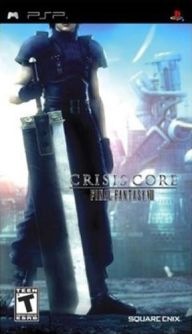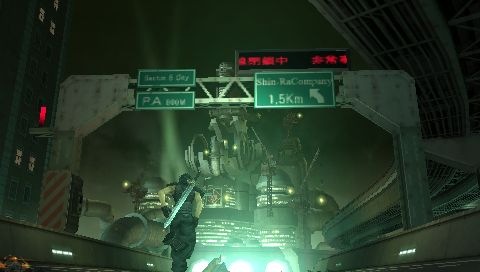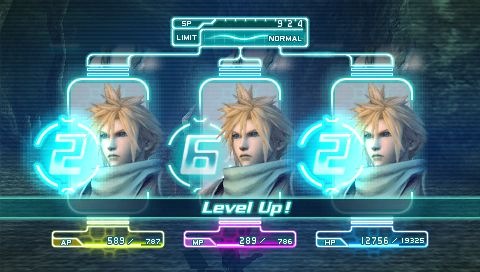 Following on the success of the immensely popular Final Fantasy 7 and the various spin-offs and media from that work, Square Enix has turned to a portable spin-off for the PSP in Crisis Core: Final Fantasy 7 that explores the character of Zack some years before the events in the main FF7 game. While the game does try to standalone from knowledge of FF7, it is best appreciated with full awareness of the previous title. The game itself is very well done and works perfectly as a PSP title, but some odd, though not game-breaking, design choices lead to the game being a lot easier than I believe the creators envisioned.
Following on the success of the immensely popular Final Fantasy 7 and the various spin-offs and media from that work, Square Enix has turned to a portable spin-off for the PSP in Crisis Core: Final Fantasy 7 that explores the character of Zack some years before the events in the main FF7 game. While the game does try to standalone from knowledge of FF7, it is best appreciated with full awareness of the previous title. The game itself is very well done and works perfectly as a PSP title, but some odd, though not game-breaking, design choices lead to the game being a lot easier than I believe the creators envisioned.
Story: A-
The game takes place in the years before the events of FF7, and focus on the history of Zack, the other SOLDIER that was present at the pivotal mission with Sephiroth and Cloud, and in fact shows the events of that mission in more detail. But before that, it presents who Zack his and how he became ranked in SOLDIER, how his friendship with Sephiroth, Cloud, and other SOLDIER and Turks came about, and how he fell in love with Aerith. Much of the plot is a mirror of the events that ultimately occur in Cloud and Sephiroth’s fate, in that another scientist has started to look into human cloning. Some of these events filter into the other FF7 media, including Advent Children and Dirge of Cerberus and despite being a prequel to all these, doesn’t seem to retcon the history already established.
Needless to say, the story won’t be as easy to follow if you’ve not played through FF7, but at the same time, they do try to make the story self-standing and only passing familarity with the existing characters is just necessary for a good appreciation of the game. There is a bit of fan service by dropping hints to other characters and events in FF7, such as a few of the side missions involving Yuffie, and the name-dropping of Cid.
As for the actual story, it’s a tad confusing at first, as there’s a bit too much overlap between the parts of the game that teach the game mechanics and that introduce all the characters. However, about 1/3rd of the way through the game, the story does get going pretty well, and, presuming you’ve worked through FF7, you’ll start to see how the pieces fall into place. The ending is pretty well done even it is clear how it will end as they help to invest time in the critical characters to make you feel them moreso than in an average RPG (it may help that you only control one character throughout the game, and thus you’re more vested in that one character than 6 or so).
Gameplay: B+
Unlike FF7, Crisis Core is more an action-based game, and designed differently from most of the other Final Fantasy titles. The main mission in the game spans several chapters, with each chapter a part of a mission for Zack through various aspects of the world. There’s no overworld, but instead you’ll be taken to each area of importance which you can then walk around to interact with the people and environment, in a manner similar to Final Fantasy XII, including down to the little dotted lines to know when you’ll cross into a new area. Once you’ve completed what you need to do in that area of the world, you move onto the next, and this process repeats for the rest of the game.
However, the main story missions are supplemented by side missions you can take at any save point. One selected, you are whisked off to the mission area, one of about eight special areas that are repeated used in the missions but have means of creating artificial barriers as to keep you confined to one part of the map. On these missions, your goal is usually to defeat one or more fixed enemies that wait at the end of the course. Successful completion gives you a reward and more missions to complete, but failing doesn’t end the game, just returns you back to the save point you were at. The only time you can die and be forced to load from a saved game is if you fall during the main story missions.
Most encounters are random and invisible, though you’ll come to recognize that the game only activates these in areas where there is enough space; there’s otherwise no distinction between standard movement and combat display. In combat, you can attack, dodge, block, use items, or use spells and abilities inferred by equipped materia. The combat is active, allowing you move out of the way of a projected attack, or get around to an opponent’s backside to inflect critical hits, and otherwise works pretty well once you get the hang of the game’s timing and approach. The game works well on the PSP as the game always locks you onto an enemy and uses a decent means of trying to keep Zack in the picture when the battle moves around. The controls are fine here – the d-pad keys work just as well as the analog nub for movement, while the attack and block are on the face buttons; the various skills and abilities are selected by tapping the shoulder buttons to move between the options. It initially takes a bit of work, but its a system that you can easily slip into.
You gain materia from missions and stores that you can access via menus at any time, but you can only equip six materia. Most of the materia from FF7 are here, including the usual magic spells, special attacks, passive abilities such as Libra to scan enemies, and stat and skill bonuses. The game gives you the ability to fuse materia together, most of the time to improve the power of one of the materia, but other times to create entirely new materia; this latter, however, is fewer and far between than I would have liked, as I only found 3 or 4 successful combinations (which you’re told of before you commit to fusion) that gave entirely new ones. Later in the game you also get the ability to add in other materials to the fusion to further boost the stats that benefit Zack.
The game’s primary trick is the “Digital Mind Wave”, two sets of 3-wheeled slot machines that run automatically in battle as long as you have Soldier Points that are gained from killing enemies. As long as you take missions, you will not run out of Soldier Points (it costs 10 to spin, I ended up with more than 400,000 SP by the end of the game), so you’ll always get the benefits of what results. The nature of the reward depends on the semi-random nature of the set of wheels with pictures of characters that Zack befriends in the game. Should two of the pictures line up, the game pauses for a moment to show you the third wheel’s result and the second set of wheels, the numbers 1-7, as they come to a stop. If all three pictures match, then Zack will automatically do a Limit Break attack that is based on the matched character (e.g. matching Aerith will massively heal you, matching Cloud will fire off a Meteor attack). In this case as well, if you get a pair of numbers on the other set of wheels, the materia in that associated slot will level up, increasing its power or benefit. Matching all 7’s will level of Zack – however, this is less a random chance and more based on an “invisible” experience meter (that is, it is impossible level Zack up by biding one’s time in a long protracted battle where you just dodge and let the DMW spin). Even if the pictures don’t line up, you will still get a bonus in battle by matching up the numbers, such as limited invincibility or no-cost spell use for a few moments. As noted the wheels are “semi-random”, as the matching will be influenced by your current Limit state, which is built up as you take damage and after certain story events; the higher the Limit meter, the more likely pictures will match up. There’s also certain points in the main story that further weight th wheel down in favor of specific characters and will also affect the chances of getting a match. Also, once you collect certain objects in the world, the wheels will sometimes change into pictures of possible Summons (your Ifrit, Bahamut, etc.) or in another case, the more comical Summons like Cait Sith, Chocobo, or Moogle. The former summons are of course super powerful attacks (with fortunately a cutscene you can skip once you’ve seen it once), while the latter usual impact a nice attack or health benefit for Zack.
The DMW mechanics is certainly unusual and has both advantages and disadvantages. One clear advantage is that when the game pauses to show you the results of the wheel stops when a match is possible, you get a brief respite from button mashing in the game. The randomness of the wheel also forces you to play smart, working for points of opportunity for back attacks or striking as a group instead of expecting to be able to fell the group in one blow. The largest drawback of the DMW is the fact that you cannot predict how it works, and thus, if you’re looking to level up your materia, you simply need to “grind” as to give enough time for the DMW to end up on matches. Fortunately, and what is a saving grace for the game, is that “grinding” is made easy through the side missions. Instead of walking around the same area between save points luring monsters into battle, the missions at least add some variety with the different areas they send you to and guarantees of reward items at the end of the day. Yes, you will have to grind, but you may not realize that you are doing it as you go along.
Even though this is a benefit of dealing with the DMW, this leads to the major drawback of the game – if you do do a lot of missions, either purposely grinding, or if you’re like me and you just have to do them, you will quickly grow super powerful and will make the main part of the game a cinch to finish. At the end of the game, I was regularly landing attacks that did 3000-4000 HP of damage, with the damage meter being maxed out at 9999; very few foes in the main storyline, including the end bosses, posed any significant challenge as a result between straight up attacks and the use of Curaga every other attack cycle; this was basically after completing about 40% of the 300 missions available, so I dare wonder what a character that’s done all 300 missions would be like. Part of this was my own playing of the games; at the start I didn’t see missions being all that value and just pumped through the first 1/3rd of the game’s main story until I got to a boss I couldn’t defeat easily (one attack was more than what I had in HP), so I spent time powering through all the missions that I could do, and repeated that pattern once every chapter or so (side note: missions are ranked from Very Easy to Very Hard depending on your stats, so as you gain power, missions that were once Very Hard will be listed as being easier. Thus, I would do all the mission up to Normal and maybe a Hard or two, and find that after running through a number, I’d have new Normal-difficult missions to take that were originally Hard or Very Hard. Thus, the missions provide a cycle that’s hard to break until you’ve basically done all you can per what you’ve opened by the main story, leaving the most difficult missions for later). Then when I got to a boss about 2/3rd through the game that I couldn’t beat, and that I had exhausted most of the available missions, I went to materia fusion and basically maxed out what I could with attack, HP and defensive bonuses. From then on, I had nearly no problems with anything on the main story (side missions were still difficult as those creatures do sometimes scale with your skill level). I don’t know if this was necessary bad or good that the game ended up being that easy to complete; Final Fantasy games are notorious for very difficult endgames but this was pretty simple. I’m sure that if you’re more intent on driving through the main game and do just the bare amount of side missions, the challenge will be there, but its hard not to see how, with those side missions calling out to you, that you wouldn’t want to make Zack as powerful as possible. I think the imbalance basically comes as a combination that the side missions not only boost your stats but also reward you handsomely (there’s some really powerful materia and items as rewards from that), and that if they had reduced the quality of the mission rewards, then there would have been more a challenge in the endgame.
That said, there is one aspect of the side missions that work to this game’s advantage, and that is the fact that they are generally short – 5 to 10 minutes – and drop you back to the save point when you are done. This is perfectly ideal for use on the PSP which you may only play in short bursts.
Value/Replayability: A-
With me having done about 40% of the 300 missions, I completed the game in about 15 hours; I would suspect that with all the missions, we’d be looking at close to 25 hrs for a 100% completed game. Your mileage may vary depending on how far you take the missions, but this is a pretty decent length for a game. That said, the main story itself, cutscenes and all, is probably only about 5-6 hrs long. Completing the game unlocks a harder difficulty , though otherwise doesn’t alter the main story.
Graphics: A
The game looks perfectly fine on the PSP – the 3D is well done, smooth, and everything is pretty clear to see on the small screen. There’s a handful of pre-rendered cutscenes as well, in the same style as Advent Children. Nothing really wrong in this area.
Audio: A-
Most of the major story points in the game are voiced, reusing past actors where appropriate for their roles. Musical themes are also reused when possible, but for the most part the game uses mostly new music. It’s not as great as other themes, but still a good soundtrack for this.
Overall: A-
Crisis Core for the most part works as a good action-based RPG on the PSP. The combat system is simple and easy to learn, it includes some of the best features of FF7, and encourages strategic thinking associated with a random element. It also has a gameplay feature via the side missions that’s well suited to playing in short bursts on the portable unit. The presentation is also spot on for a Square Enix game. However, if there is a fault, it is that the combination of game elements seems to direct the player into easily creating an over-powered character through the side missions, resulting in the main story side being less of a challenge than most Final Fantasy games. This is not necessary game-breaking, but an odd design decision that makes you wonder if the designers thought everything through. Regardless, the game does try to create something that stands alone from FF7 if you’ve not played it, but the game is best enjoyed with full knowledge of the earlier title.
Filed under: action, crisis-core-final-fantasy-vii, jrpg, playstation-portable, review |







Final Fantasy Review is nice
Cloud and Yuffie are my best characters in all of the FF7 games;P
Damn man i wish there could be more comments for
LOL
Yo; if anyone reads this FF7 blog or comments please leave me your email;P
i’ll give u info or FF downloads that u may want to know about, anything that u want, just leave more comments, keep um coming LOL